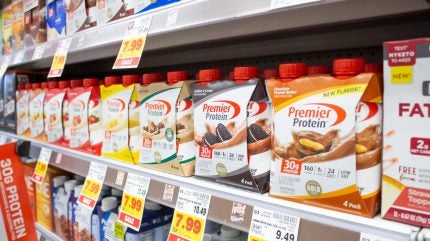
BellRing Brands expects margins to be pressured by inflation in the back half of the year, along with a sales “headwind” from retailer inventory reductions.
However, the US-based protein business left sales and EBITDA guidance unchanged for the full year as president and CEO Darcy Davenport presented second-quarter results.

Discover B2B Marketing That Performs
Combine business intelligence and editorial excellence to reach engaged professionals across 36 leading media platforms.
Her finance counterpart Paul Rode pointed to a “minor” impact from tariffs, with that impact likely to be felt in fiscal 2026 rather than the current year, mainly linked to dairy protein ingredients sourced from Europe and New Zealand.
“Our pricing actions have offset input-cost inflation to date. However, the rate of inflation will increase in the second half of 2025, pressuring margins when compared to the prior year,” Rode explained on a follow-up call with analysts.
While the sales outlook for the second half remains unchanged, sales will be supported by promotions in the final quarter of 2024 but offset by “third-quarter reductions in retailer trade inventory levels”, he said.
Rode added: “Starting late in Q2 and continuing into the third quarter, several key retailers lowered their weeks of supply on hand, which is expected to be a mid-single-digit headwind to our third-quarter growth. This change is in addition to the previously anticipated mid-single-digit impact to the third quarter from lapping last year’s trade inventory replenishments.

US Tariffs are shifting - will you react or anticipate?
Don’t let policy changes catch you off guard. Stay proactive with real-time data and expert analysis.
By GlobalData“We now expect Q3 net sales growth of low-single-digits with Premier Protein the main driver and all others flat to down. Without the impact of these trade inventory changes, our underlying third-quarter growth for Premier Protein RTD shakes would be more in line with our expected consumption growth of mid-to-high teens.”
Sales in the quarter to 31 March rose 18.9% to $588m based on 15.3% volume growth and an increase in price/mix of 3.6%.
Adjusted EBITDA climbed 14.4% to $118.6m, with the margin dipping to 20.2% from 21%.
Sales over 2025 were reaffirmed at $2.26-2.34bn (13-17% growth) and adjusted EBITDA of $470-500m (7-14%).
Rode said the adjusted EBITDA margin will remain “healthy” at 21.1% at the “midpoint” but in the fourth quarter will be “sequentially lower as higher input-costs and promotional spend weigh on margins”.
BellRing on tariffs
In terms of tariffs, the CFO said a “portion” of the company’s input costs could be hit by the levies related to the dairy ingredients from Europe and New Zealand. But BellRing Brands expects no impact in 2025 and a “partial” impact the following year due to the sourcing lag on the P&L account.
Nevertheless, Rode said the company is “actively evaluating ways to mitigate tariff impacts”.
He added: “The dairy inputs for our business are, call it a third to 40% of our total cost of goods sold. But only a portion of those are subject to tariffs. Our powder business is pretty much insulated on shakes. Some of our dairy proteins do come from New Zealand and the EU, which currently are contemplated at a 10% tariff.”
Rode estimated a low-single-digit effect on the cost of goods sold if the current tariff levels remain unchanged, what he called “relatively minor”.
Meanwhile, Davenport suggested BellRing Brands was not feeling the same “impact of the weakening consumer” on its protein categories as other US food manufacturers have recently indicated in their results.
“While we have some puts and takes in the second half… I am pleased that our outlook and consumption remain resilient and strong,” Davenport said. “Even though broad consumer sentiment is weakening, protein, and specifically our category, remain incredibly healthy.”
However, she noted some caution in providing an unchanged outlook.
“We have visibility into promotional plans. We have visibility into marketing. We have visibility to our distribution gains. But there are still some unknowns, and part of that is the consumer backdrop and what’s going on there,” Davenport explained.
“I think that our approach has been cautious and we will continue to be that way as the consumer is a bit more unstable than we’ve seen in the past.”
Navigate the shifting tariff landscape with real-time data and market-leading analysis.
Request a free demo for GlobalData’s Strategic Intelligence here.





